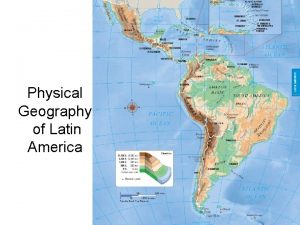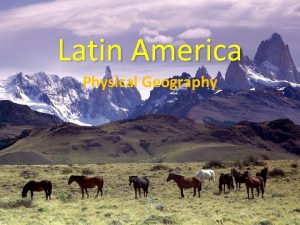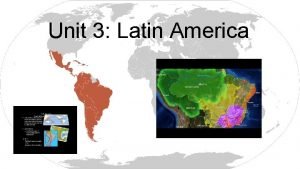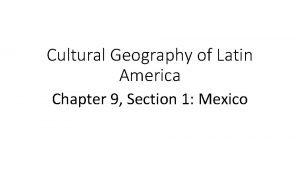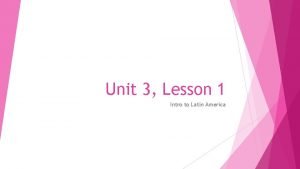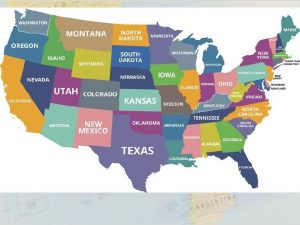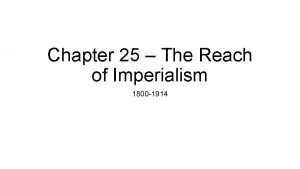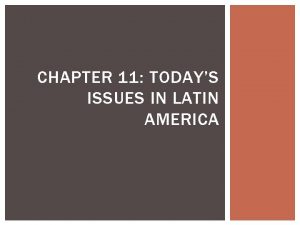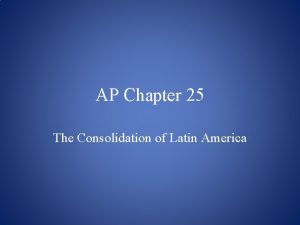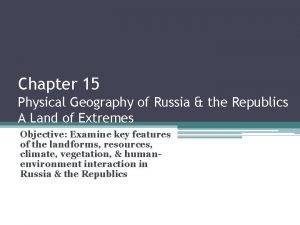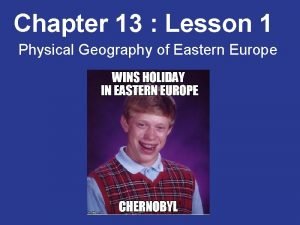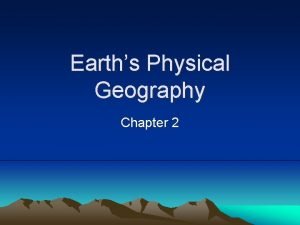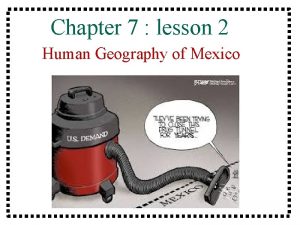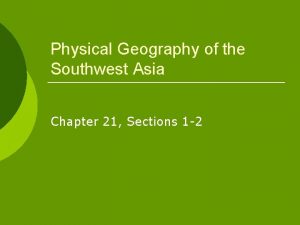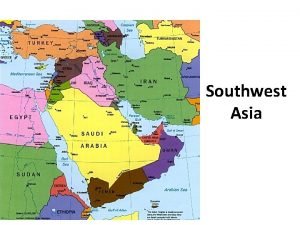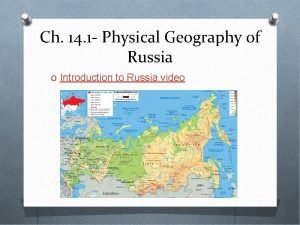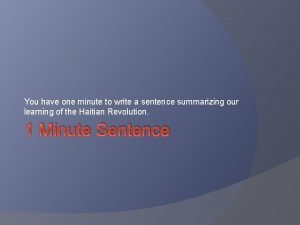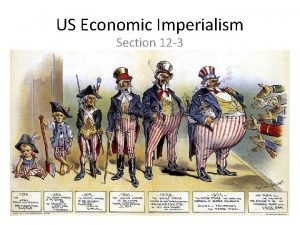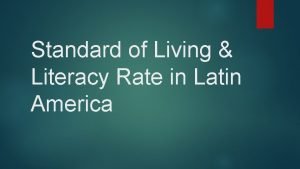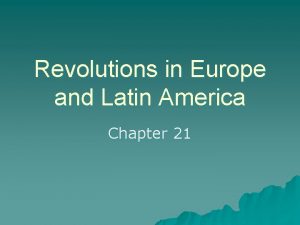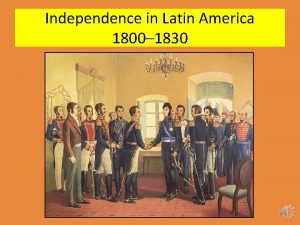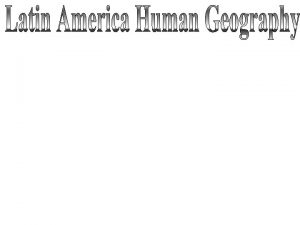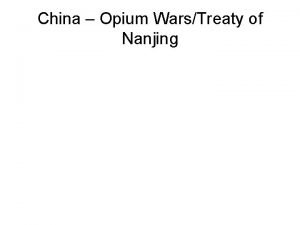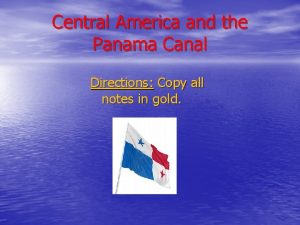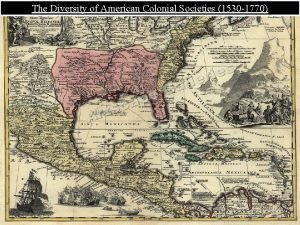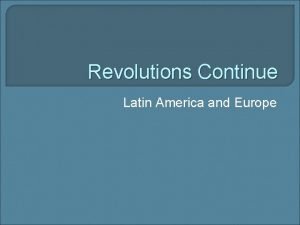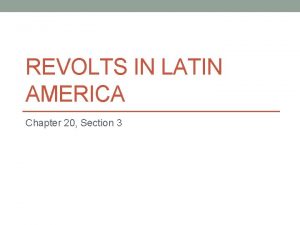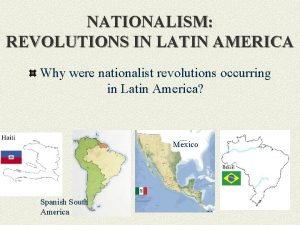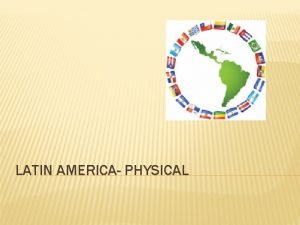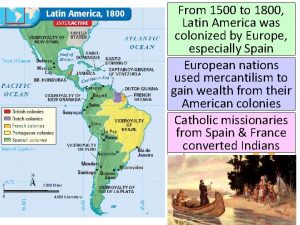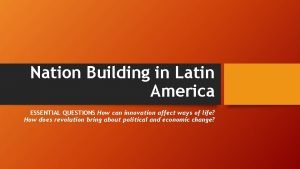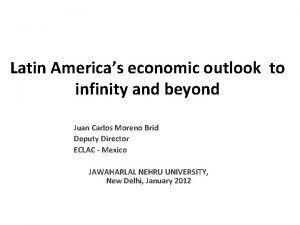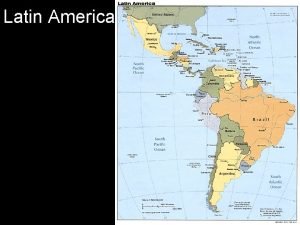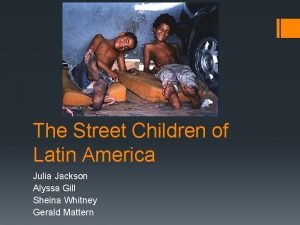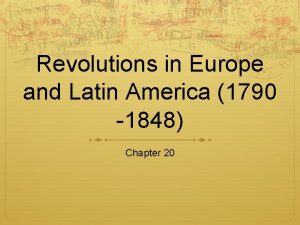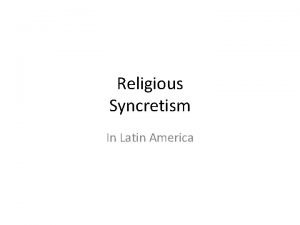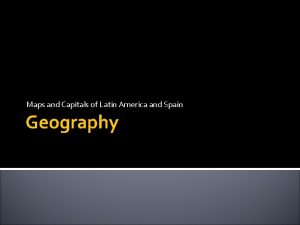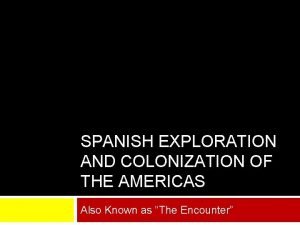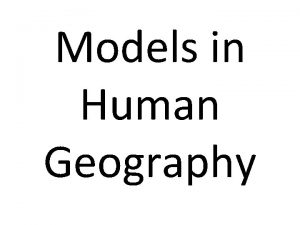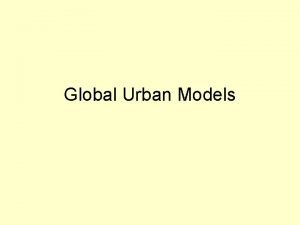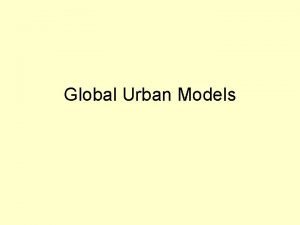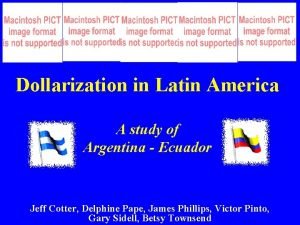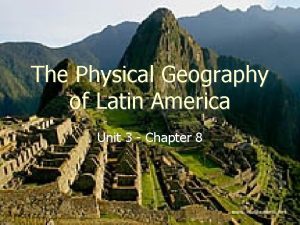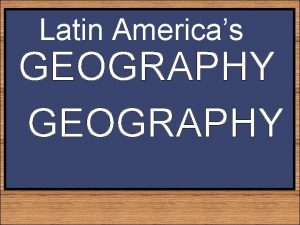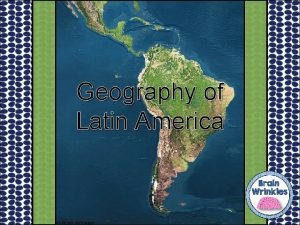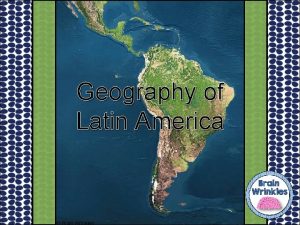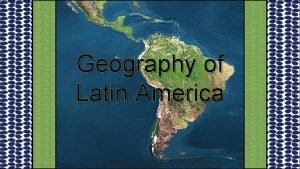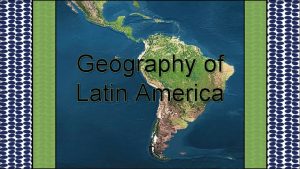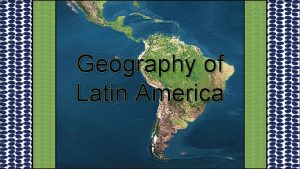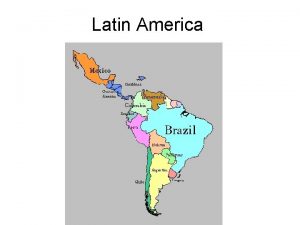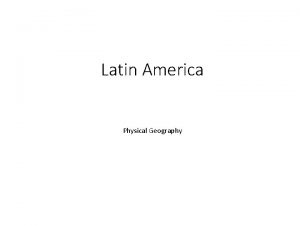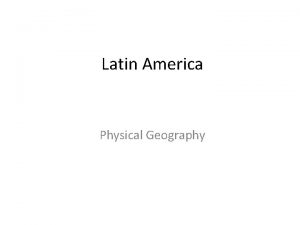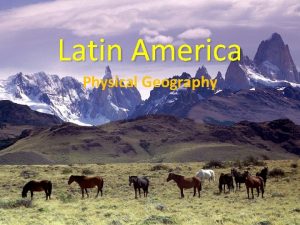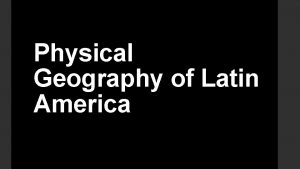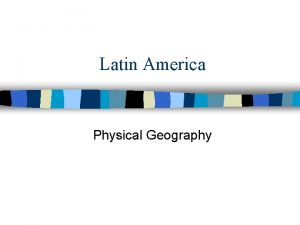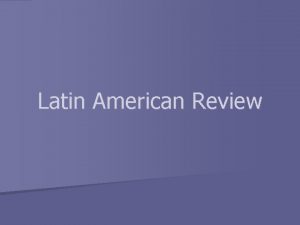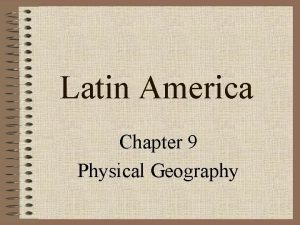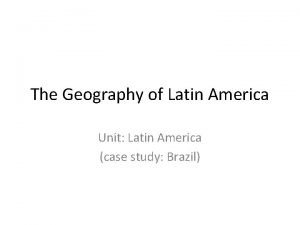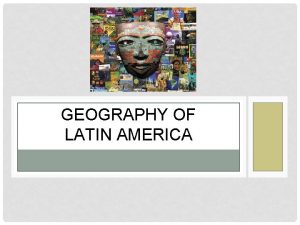Chapter 9 11 Physical Geography of Latin America






























































- Slides: 62

Chapter 9 -11 Physical Geography of Latin America: From the Andes to the Amazon • From rain forests and mountain ranges, to deserts and savannas, Latin America • is rich with varied beauty, resources, and plant and animal life. 1

Landforms and Resources - Latin America’s landforms include highlands, lowlands, mountains, and plains. - The Andes Mountains and the Amazon River are the region’s most remarkable physical features. 2

Mountains and Highlands An Enormous Span - Latin America spans 7, 000 miles - from U. S. -Mexico border to Tierra del Fuego - part of North America, all of Central and South America, Caribbean The Andes Mountains - Andes Mountains—South American range along western side of continent - part of chain that includes Rockies in U. S. , Sierra Madre in Mexico - barrier to interior forced settlement along eastern, northern coasts - once home to Inca civilization in Peru; has many active volcanoes 3

Highlands - Highlands—mountainous or hilly areas of country - Guiana Highlands are in northeast section of South America - highlands cover parts of Venezuela, Guyana, Suriname, French Guiana - Brazilian Highlands are located along east coast of Brazil Plains for Grain and Livestock Llanos of Colombia and Venezuela - Llanos—grassy, treeless areas used for livestock grazing, farming - similar to Great Plains of U. S. or pampas of Argentina 4

(Destionation 360. com) Plains of Amazon River Basin - Cerrado—flat savannas with moderate rainfall, good for farming - found in interior of Brazil, mostly undeveloped Pampas of Argentina and Uruguay - Pampas—areas of grassland, rich soil, used for cattle and wheat - home to gaucho culture centered on horsemen 5

The Amazon and Other Rivers Central American Rivers - Central America, Caribbean: bordered by water, fewer river systems - North America’s Rio Grande forms border between U. S. and Mexico - less dependent on rivers for transportation than South America Orinoco River - Orinoco River— 1, 500 miles through northern South America to Atlantic - flows partly along Venezuela-Colombia border, drains interior lands - home to continent’s few remaining native peoples 6

Amazon River - Amazon River—flows 4, 000 miles, from west to east, to Atlantic - branches start in Andes - fed by over 1, 000 tributaries - carries more water than next seven largest rivers combined Paraná River - Paraná River— 3, 000 miles, starts in Brazilian highlands - flows south and west through Paraguay, Argentina, turns eastward - between Argentina and Uruguay becomes estuary Rio de la Plata - Estuary—wide lower course of river where its current is met by tides 7

Major Islands of the Caribbean Columbus and the West Indies - West Indies: Bahamas, Greater Antilles, Lesser Antilles - site of Columbus’ landing; later Spanish base for mainland conquest Bahamas - Hundreds of islands off southern Florida, north of Cuba - Nassau is largest city and capital 8

The Greater Antilles - Larger islands in Caribbean: Cuba, Jamaica, Hispaniola, Puerto Rico - Hispaniola divided between Haiti, Dominican Republic The Lesser Antilles - Smaller islands southeast of Puerto Rico - Windward Islands face winds that blow across them - Leeward Islands are sheltered from prevailing northeasterlies 9

Resources of Latin America A Treasure House - Region is rich with minerals, energy resources, agriculture, forests Mineral Resources - Gold, silver, iron, copper, bauxite (aluminum ore), lead, nickel - also precious gems, tin, titanium, tungsten - South America is a world leader in mining, exporting raw materials - Example: Jamaica used to be plantation economy (bananas, sugar) - began bauxite mining to reduce dependency on agriculture, tourism 10

Energy Resources - Oil, coal, natural gas, uranium, hydroelectric power is plentiful - Brazil rich in hydroelectric power (from rivers, waterfalls), oil, gas - Trinidad has natural gas; major exporter of methanol, ammonia - Venezuela, Mexico have major oil deposits, export oil to world 11

Climate and Vegetation - Latin America has a variety of climates, from the cold peaks of the Andes to the Amazon rain forest. - The vegetation of Latin America ranges from grasslands to the largest rainforest in the world. 12

A Varied Climate and Vegetation Reasons for the Variety - Latin America’s broad range of climate, vegetation due to 3 factors: - it spans great distances on either side of the equator - it has big changes in elevation due to the mountains - its climate’s affected by both warm Atlantic, cold Pacific currents 13

Tropical Climate Zones Tropical Wet - Rain forests—dense forests with different species of trees - hot and rainy all year - unique ecosystem—community of plants, animals living in balance - Largest is Brazil’s Amazon rain forest with 2 million square miles - 2, 500 types of Amazon trees - animals include anaconda, jaguar, piranha 14

Tropical Wet and Dry - Savannas found in Brazil, Colombia, Argentina - hot with seasonal rain Dry Climate Zones Semiarid - Dry climate with some rain - home to vast, grass-covered plains or desert shrubs - found in Mexico, Brazil, Uruguay, Argentina Desert - Found in north Mexico, coast of Peru, north Chile’s Atacama Desert - parts of Argentina’s southern Patagonia are desert - Vegetation is mostly shrubs growing in gravel or sand 15

Mid-Latitude Climate Zones Humid Subtropical - Rainy winters and hot, humid summers; varied vegetation - parts of Paraguay, Uruguay, south Brazil and Bolivia, north Argentina Mediterranean - Hot, dry summers and cool, moist winters - vegetation is chaparral (drought-resistant trees) - this is the climate of part of Chile along the west coast - climate similar to that of California 16

Marine West Coast - Cool, rainy winters and mild, rainy summers; forest vegetation - occurs in southern Chile and Argentina - similar to the climate of Oregon or Washington - Varies from moderate to cold due to elevation, wind, sun, landscape - found in mountains of Mexico and South America 17

Human-Environment Interaction - The people of Latin America have altered the land through agriculture and urbanization. - Tourism is having a growing impact on the environment of Latin America. 18

Agriculture Reshapes the Environment Slash-and-Burn - Slash-and-burn—cut trees, brush, grass; burn debris to clear fields - used by native peoples and today by poor farmers in Amazon basin - they move to new area when soil is exhausted - one reason for shrinking rain forests 19

Terraced Farming - Terraced farming—step-like farm fields cut into mountains, hillsides - lets crops grow on steep land, cuts down on soil erosion - used by Incas in Peru, Aztecs in Mexico 20

Urbanization: The Move to the Cities From Country to City - Highly urbanized countries: Argentina, Chile, Uruguay, Brazil - Subsistence farming barely supports people and their families - they move to cities to improve their lives - Push factors—factors that “push” people to leave rural areas - poor medical care, poor education, bad jobs, only rich few own land - Pull factors—factors that “pull” people to cities - better jobs, schools, medical care 21

Rapidly Growing Cities - Six of Latin America’s most populous cities are in South America - Sao Paulo and Rio de Janeiro, Brazil; Lima, Peru - Buenos Aires, Argentina; Bogota, Colombia; Santiago, Chile - Most populous city in Latin America is Mexico City - 18 to 20 million in city, 30 million in greater metropolitan area 22

Rapidly Growing Cities - Similar problems affect cities throughout region - growing slums - increasing unemployment and crime - environmental problems include air pollution, drinking water shortages - Governments can’t afford facilities to support population increases - failing infrastructure—sewers, transportation, electricity, housing 23

Tourism: Positive and Negative Impacts Advantages of Tourism - Tourists spend money on souvenirs, trips, restaurants - new hotels, businesses have been built in Mexico and the Caribbean - regional ports serve cruise ships - residents work in restaurants and resorts, guide tours and activities - Helps reduce income gap between rich and poor 24

Disadvantages of Tourism - Resorts built in unspoiled settings create congestion, pollution - Gap between rich tourists and poor residents creates resentment - Local governments run up debt to build tourist facilities - airports, harbors, hotels, resorts, sewage systems, shopping malls - Facility owners often live out of country, so profits leave the area - such owners make decisions that may not be in area’s best interest 25

Native Americans and the Spanish Conquest • Native peoples: ________ • Spanish conquest—Hernando Cortés landed on the Mexican coast in 1519 • Spaniards march to • Tenochtitlán (site of • Mexico City today) • conquest is complete • by 1521 Teotihuacán Ruins Planetware. com 26

Colony and Country • Gold and silver made Mexico an important part of Spanish empire • Agustín de Iturbide led 1821 Mexican independence, became emperor • In mid-1800 s Benito Juarez led reform, became president, sought: • separation of church and state, better education, and more even distribution of land. 27

• Porfirio Diaz followed Juarez; his harsh, corrupt rule lasted 30 years • Francisco Madero, Pancho Villa, Emiliano Zapata led revolution • 1917 constitution gave half of farmland to peasants Emersonkent. com Madero Villa Zapata 28

One-Party Rule Fox Cnn. com • Institutional Revolutionary Party (PRI)—new political party in 1929 brought stability, but democracy was undermined by fraud and corruption. • National Action Party’s Vicente Fox became president in 2000 • PRI’s 71 -year control ends, Mexico became more democratic • Who is the current president of Mexico? _________ Calderon 29

The Aztecs and the Spanish • Aztec empire in Valley of Mexico centered on capital, Tenochtitlán • Cortes and Spanish destroyed capital, built Mexico City on ruins • Spanish brought their own language and religion; • Indian heritage stayed strong. • Creation of a large mestizo population—mixed Spanish and Native American heritage Nndb. com 30

An Architectural Heritage • Native Americans constructed beautiful pyramid temples, palaces • Spanish built missions, huge cathedrals Clccharter. org Sacred-destinations. com 31

Economics: Cities and Factories • Population and the Cities • People moved to cities seeking better jobs • 1970 population (52 million) doubles by 2000 to 104 million people Rediff. com 32

Oil and Manufacturing • Gulf oil reserves help Mexico develop industrial economy, manufacturing with many new factories along U. S. border • Maquiladoras—factories that assemble imported materials. Export products (electronics, clothes) to U. S. • Part of NAFTA (North American Free Trade Agreement) with U. S. and Canada • Prosperity through trade is expected 33

Central America and the Caribbean • Native peoples, Europeans, and Africans have shaped the culture of this region. • The economies of the region are based primarily on agriculture and tourism. airamericancaribbean. com 34

Native and Colonial Central America • Cultural hearth—place from which important ideas spread often heartland, or place of culture’s origin. • Mayan civilization spread throughout Central America. It is unknown why the Maya abandoned many cities in 800 s. Civilization. ca 35

Mayan Influence • Built cities, temples in Belize, Guatemala, El Salvador, Honduras • City-states were ruled by godkings • Center of Mayan civilization was Tikal in northern Guatemala • spread influence over region, from Mexico to El Salvador Interzone. com 36

Native and Colonial Central America • Spain ruled until mid-1800 s • United Provinces of Central America—formed in 1823 Central America declared independence from Mexico. • United Provinces split apart by late 1830 s. El Salvador, Nicaragua, Costa Rica, Guatemala, Honduras, Panama later broke from Colombia; Belize from British Honduras. 37

Native and Colonial Caribbean • In 1492 Columbus thought he’d reached East Indies but had actually landed in the Bahamas • Spanish established sugar plantations, used Taino as forced labor • Disease, mistreatment kill many Taino • Spanish brought African slaves, who then influenced Caribbean culture 38

A Colonial Mosaic • By 1800 s Spanish, French, English, Danish, Dutch all claimed islands. • Sought profits from sugar trade, and depended slaves from Africa. 39

Caribbean Independence • First successful slave revolt took place in Haiti • Toussaint L’Ouverture led a rebellion in 1790 s, took over government • Haiti achieved independence from France in 1804 • 1898 Spanish-American War gave Cuba independence from Spain. • Jamaica, Trinidad and Tobago became independent from Britain in 1962. 40 En. wikipedia. org

Farming and Trade • Sugar cane is Caribbean’s largest export crop. Also trade bananas, citrus, coffee, and spices. • Poor crop-labor pay leaves Caribbean’s percapita income very low • Central America plantations produce 10% of world’s coffee, bananas • mining and forest resources are also exported • Panama Canal cuts through land bridge, connects Atlantic, Pacific. Canal traffic makes Panama an important crossroads of world-trade. 41

Culture of Central America • Blends Native American and Spanish settlers’ influences • Spanish language, religion (Catholicism) still dominant today • Took land from natives, cleared it to plant new crops such as wheat Pnac. org 42

Popular Culture, Tourism, and Jobs • Music of the Caribbean • Trinidad’s steel drum calypso music has elements from Africa, Spain • Jamaican reggae music deals with social, and religious issues. Has roots in American, African music 43

Spanish-Speaking South America Native peoples and settlers from Spain have shaped the culture of South America. Languages • Spanish-speaking nations: Argentina, Bolivia, Chile, Colombia, Ecuador, Guyana, Paraguay, Peru, Uruguay, Venezuela. • Suriname is Dutch-speaking; French Guiana is part of France. 44

The Inca • Inca—great civilization built in the harsh terrain of the Andes • From their capital at Cuzco, Peru the Incas established an empire • Built 20, 000 miles-long road system that crossed mountains & deserts to link their empire Wadsworth. com 45

The Spanish Conquest • Pizarro conquered Incas for Spain; wanted Incan gold, silver • Forced natives to work mines, farms; many abused, worked to death • Moved Inca to plantations, disrupting families, communities • Spanish replaced Inca’s Quechua language, millions still speak it 46

Independence Movements • South American countries sought independence in early 1800 s • Simón Bolívar helped liberate Colombia, Venezuela, Ecuador, Bolivia • José de San Martín leads Argentina, Chile, Peru. • Geography (mountains, rain forests) kept countries from unifying • Limited interaction meant underdevelopment, political instability Biography 4 u. com 47

Government by the Few • Since independence, many countries governed by oligarchy (government by the few) or military rule • Authoritarian rule delayed development of democracy • Effects of colonialism: strong armies, weak economies, class divisions 48

A Cultural Mosaic: Varied and Separate • South America is a complex mosaic; cultures adjacent but separate. How would Geography keep cultures separated? 49

Literature • A strong literary heritage; 20 th century novelists world famous • Colombia’s Gabriel García Márquez wins 1982 Nobel Literature prize Music • Popular music combines Indian, African, European elements • Many cities have symphonies and opera companies Goodreads. com 50

Economies of the Region • Wide variety of products due to resources, land, climate, vegetation • Colombia, Venezuela: oil reserves • Peru: fishing; Ecuador: shrimp; Bolivia: tin, zinc, copper • Argentina, Uruguay: agriculture; Paraguay: soybeans, cotton, hides 51

Chile’s Success Story • Engages in global trade; largest export is copper • Exports its produce north; harvest is during North American winter 52

Literacy in South America • Spanish-speaking South American countries have high literacy rates • better than Central America, Caribbean, Mexico, Brazil • 90% in Argentina, Chile, Uruguay with rates for women as high as men 53

Brazil • Native peoples, Portuguese, and Africans have shaped Brazil. • Brazil has the largest territory and the largest population of any country in Latin America. 54

A Divided Continent: Native Peoples and Portuguese Conquest • Treaty of Tordesillas— 1494 agreement between Spain and Portugal gave Portugal control of what would become Brazil. Line of Demarcation-Pope • 1– 5 million native Americans in area before colonists arrived in early 1500 s • No gold, silver, so colonists cleared forests for sugar plantations. Settled coast, put natives to work on plantations in interior. • Natives die of European diseases, so African slaves were brought in • Today, Brazil is mix of European, African, and native ancestry 55

Independence for Brazil • Portuguese colony from 1500 to 1822 • Napoleon invaded Portugal in 1807 • Portuguese royal court moved to Brazil • Brazil sought independence after Napoleon’s defeat in 1815 • Brazilians petition Dom Pedro, son of Portugal’s king, to rule. Dom Pedro agrees, declares independence in September 1822. En. wikipedia. org 56

• The People of Brazil • Today 200, 000 native peoples remain in Amazon rain forest • Immigrants come from Portugal, Germany, Italy, Spain, Lebanon, and Syria. Largest Japanese population outside Japan. • Language and Religion • Portuguese is spoken; largest Catholic population in world. 20% Protestant; others practice mix of African beliefs and Catholicism. 57

Brasilia: • In 1957 Oscar Niemeyer begins designing new capital set 600 miles inland in order to draw people to interior. Lonelyplanet. com 58

An Industrial Power • Driven by an abundance of natural resources: iron, bauxite, tin, manganese, gold, silver, titanium, chromite, tungsten, quartz. • electricity from power plants on numerous rivers, including Amazon • large reserves of oil, natural gas • Highly industrialized, including steel, automobile plants 59

Migration to the Cities • Vast gap between rich and poor; poor seek jobs in cities • urbanization occurs as people are pushed off land, manufacturing grows • in 1960, 22% lived in cities; in 1995, 75% lived in cities Migration to the Interior • 80% live within 200 miles of ocean, but there’s been a move inward • Interior economy is based on farming of cerrado—fertile grasslands Connectinclassrooms 2 pbworks. com 60

From Carnival to Martial Arts • Carnival—colorful feast day in Brazil and Caribbean countries. Features music of the samba—Brazilian dance with African influences • Capoeira—Brazilian martial art and dance with African origins Gocarribeanabout. com 61

City Life in Rio de Janeiro • Rio de Janeiro is cultural center of Brazil • Lovely setting: Sugarloaf Mountain, Guanabara Bay, Copacabana Beach • Poverty creates favelas (slums), crime, drug abuse 62 Vecd. org
 Chapter 8: the physical geography of latin america answers
Chapter 8: the physical geography of latin america answers Why is it called latin america
Why is it called latin america Middle america
Middle america Pampas physical map
Pampas physical map Unit 3 latin america
Unit 3 latin america Chapter 9 cultural geography of latin america answers
Chapter 9 cultural geography of latin america answers Voluntary trade cloze notes 1 answer key
Voluntary trade cloze notes 1 answer key Traje tipico de soloma
Traje tipico de soloma Latin america webquest
Latin america webquest Lesson 1 latin america africa and the middle east
Lesson 1 latin america africa and the middle east Middle america
Middle america Latin america physical features
Latin america physical features Where is latin
Where is latin South america physical features
South america physical features The reach of imperialism vocabulary activity
The reach of imperialism vocabulary activity Chapter 11 today's issues in latin america
Chapter 11 today's issues in latin america Chapter 25 the consolidation of latin america
Chapter 25 the consolidation of latin america Chapter 27 physical geography of east asia
Chapter 27 physical geography of east asia Russia and the eurasian republics physical map
Russia and the eurasian republics physical map Lesson 1 physical geography of southeast asia
Lesson 1 physical geography of southeast asia Lesson 1 physical geography of the russian core
Lesson 1 physical geography of the russian core Earth's physical geography chapter 2
Earth's physical geography chapter 2 Lesson 2 human geography of canada
Lesson 2 human geography of canada Chapter 5 lesson 1 physical geography of the united states
Chapter 5 lesson 1 physical geography of the united states Map of southwest asia
Map of southwest asia Chapter 21 physical geography of southwest asia
Chapter 21 physical geography of southwest asia Reteaching activity 14 physical geography of russia
Reteaching activity 14 physical geography of russia America america you mean the world to me
America america you mean the world to me Asia africa europe north america south america
Asia africa europe north america south america Whats an onomatopeia
Whats an onomatopeia Happening body art
Happening body art Plateau facts
Plateau facts Peninsulares
Peninsulares Economic imperialism definition
Economic imperialism definition South america literacy rate
South america literacy rate Revolutions in europe and latin america section 1 quiz
Revolutions in europe and latin america section 1 quiz Latin american city model
Latin american city model Latin america hierarchy
Latin america hierarchy Largest economy in latin america
Largest economy in latin america Latin america hierarchy
Latin america hierarchy Latin america acrostic
Latin america acrostic Caste system in latin america
Caste system in latin america Class system in latin america
Class system in latin america Discontent in latin america worksheet answers
Discontent in latin america worksheet answers Class system in latin america
Class system in latin america Landforms in latin america
Landforms in latin america Latin america 1500 to 1800
Latin america 1500 to 1800 How were nationalist revolts in latin america
How were nationalist revolts in latin america Mendel latin america 15m series infinity
Mendel latin america 15m series infinity Tropic of capricorn south america
Tropic of capricorn south america Christmas in latin america and spain
Christmas in latin america and spain Lad latin america
Lad latin america Street children in latin america
Street children in latin america Revolutions in europe and latin america
Revolutions in europe and latin america Religious syncretism in latin america
Religious syncretism in latin america Latin america and spain map
Latin america and spain map Social class pyramid of latin america
Social class pyramid of latin america Distance decay model human geography
Distance decay model human geography Latin city model
Latin city model Latin american model
Latin american model Dollarization in latin america
Dollarization in latin america Unit 3 latin america
Unit 3 latin america Latin america climate zones
Latin america climate zones


